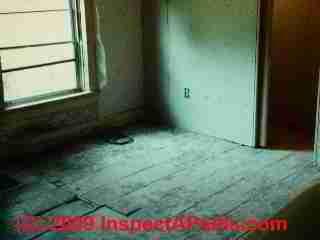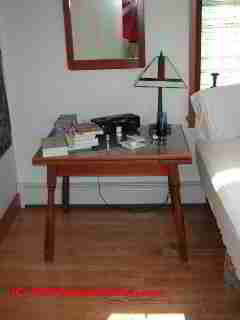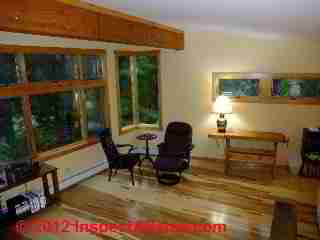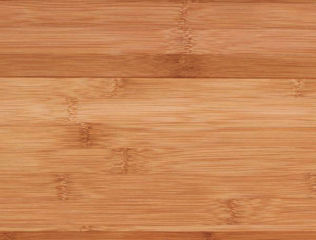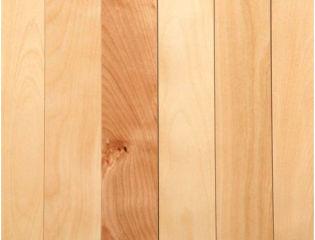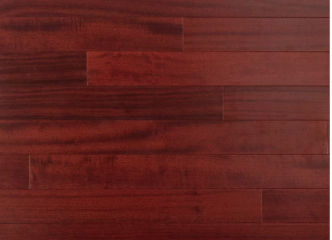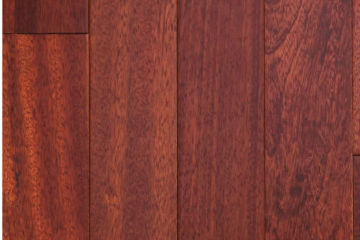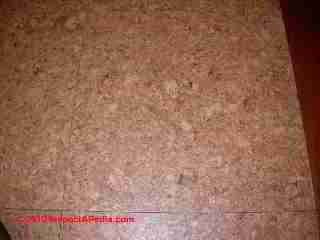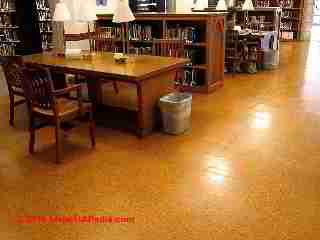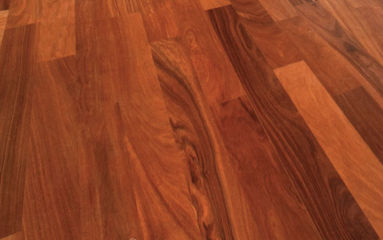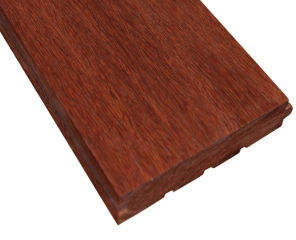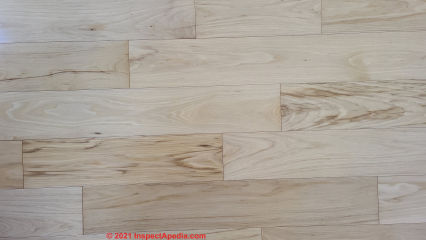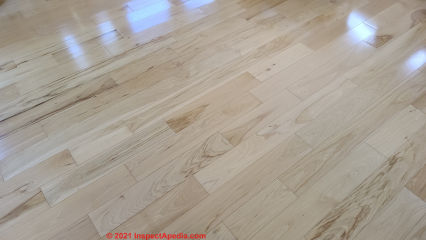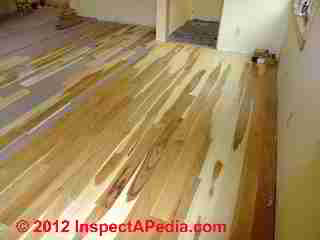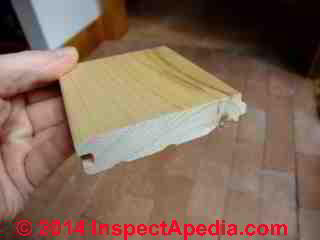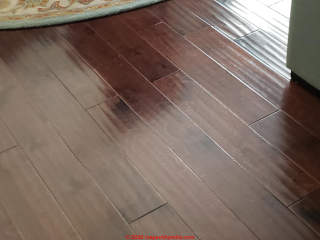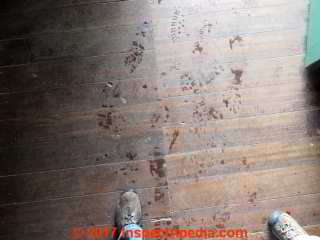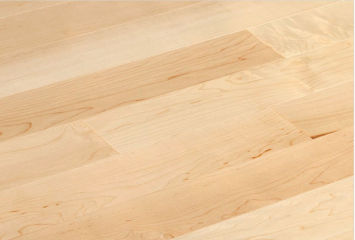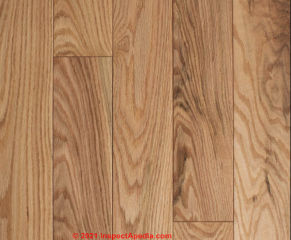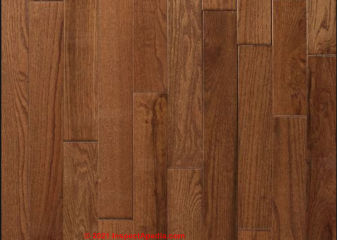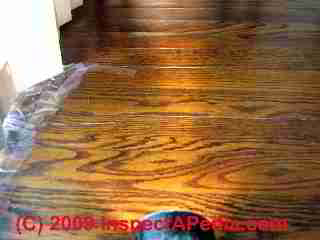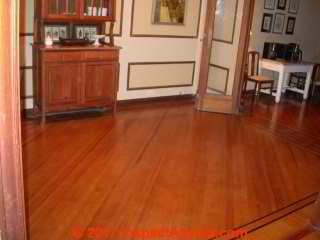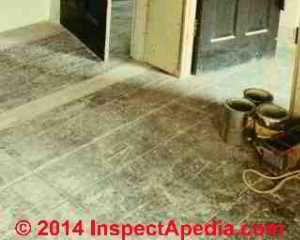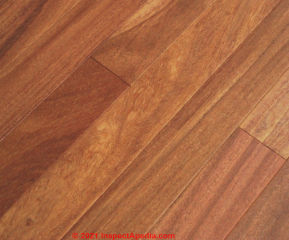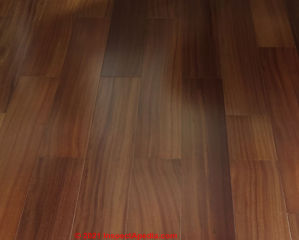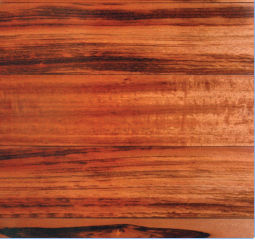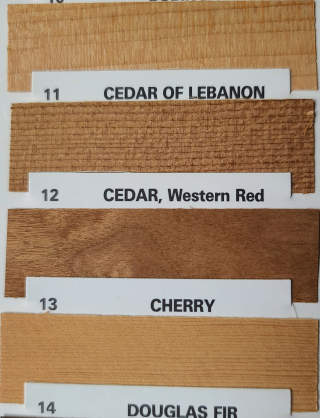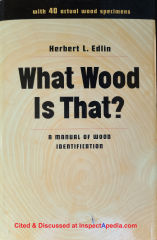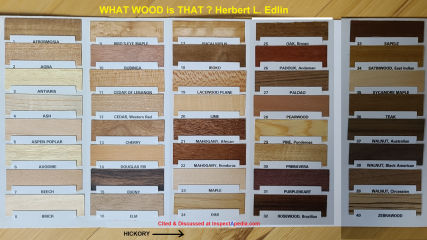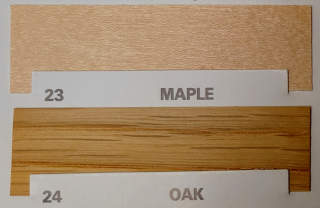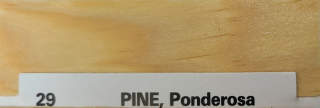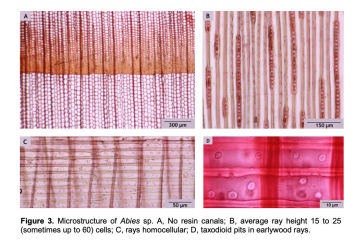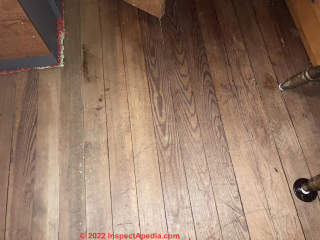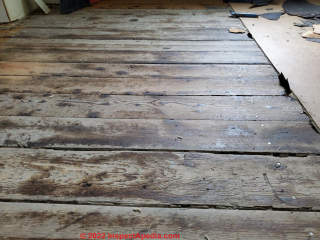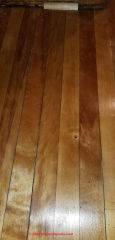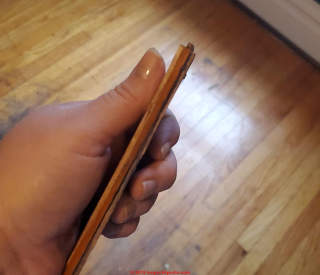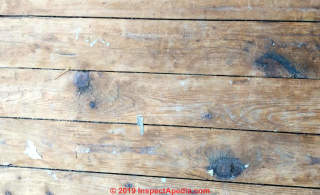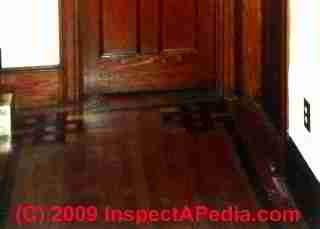 Guide to Kinds of Wood Flooring Materials
Guide to Kinds of Wood Flooring Materials
Photo guide to identifying kinds of wood & wood flooring
- POST a QUESTION or COMMENT about how to identify different types of wood floors & flooring materials & how they may indicate the age of a building
Types of wood flooring: A photo guide to all types and ages of wood flooring in buildings. The list of flooring types by wood species, widths, thickness, edge types (square, shiplap, tongue & groove), and the history and age of the use of these products in buildings is enormous.
Here we provide photographs of a collection of wood flooring types as an aid to flooring restorers, preservationists, and inspectors wishing to determine the age of a building and its materials.
The age of a building can be determined quite accurately by documentation, but when documents are not readily available, visual clues such as those available during a professional home inspection can still determine when a house was built.
InspectAPedia tolerates no conflicts of interest. We have no relationship with advertisers, products, or services discussed at this website.
Types or Species & Ages of Wood Floors Used in buildings
Warnings to Wood Floor Restorers
The properties of wood as well as its coatings change over time. Wideboard shiplap-edged floors in an 1860's house we restored in Wappingers Falls NY had been coated with a paint made of oxblood and milk. 125 years later this coating was difficult to remove.
Not wanting to use modern floor sanders to make the floors in this historic home dead flat, we tried sanding with portable sanders and found ourselves replacing the sanding belt or disc ever few minutes. Water or other chemicals did not help. We resorted to hand scraping and sanding.
Our antique wide board flooring photos (below) show before and after photographs of the wide board flooring repaired and restored by the author [DF]. These soft pine boards were edged in a ship-lap or "L" cut design [Image] in which about 50% of the each board edge is rabbeted or cut away.
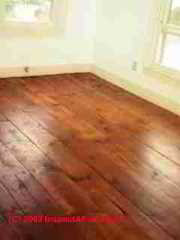
Older solid wood boards typically used before 1800 in the Northeastern U.S. often were made of solid 1" thick boards with squared and butted edges.
Watch out: do not fill gaps between shiplap cut or tongue-and groove cut wood floor boards.
At WOOD FLOOR DAMAGE we discuss causes and proper treatment of gaps between wood floor boards.

Wood also may become very hard with age. This example about chestnut trim applies to salvaging old wood flooring as well. Removing old trim may require the simultaneous use of multiple thin pry bars to avoid ruining the material.
Nails should be removed from the back of the trim, not the front, by pulling the nail through the wood board. If you try to hammer nails back out from the back to the front or exposed face of the board the nail head will usually split and damage the face of the trim board.
We removed chestnut trim boards in this 1900 home (photo at left) in Poughkeepsie, NY to route new electrical wiring in the lower walls.
It was impossible to nail these beautiful boards back in place - it was like nailing iron. Every nail hole had to be drilled to avoid damaging the wood. The flooring shown here is a combination of 1900's vintage strip flooring and inlay.
Wood Inlay & Parquet Flooring

Continuing with another photo of the Poughkeepsie home built ca 1900, the parquet flooring was surrounded by wood inlay border.
Unfortunately this floor had been sanded several times, resulting in parquet and trim so thin that only the most gentle, non-destructive re-finishing was feasible.
Where parquet sections had come loose a previous owner had secured them with many tiny wire nails.
These were removed by the author, loose pieces were cleaned, and the repaired sections were re-glued to a backer and replaced in the floor.
The result was a salvaged "too thin to sand" but beautiful 1900 parquet floor.
See details
at PARQUET WOOD / VINYL FLOORING
Modern Narrow-Width Solid Wood Strip Flooring
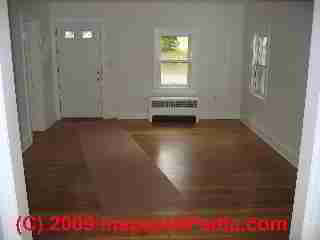
Widespread popular use of thin-width 3/4" thick wood strip flooring began in the U.S. in the 1920's and continued to the 1980's.
Look closely at the edge of the floor, perhaps pulling up quarter-round or baseboard floor trim to expose the very perimeter of the floor, and you may be able to determine how much thickness of the wood has been lost from prior re-sanding and re-finishing.
Our photo, left, shows original pine flooring in a 1920 home restored by the author in Poughkeepsie, NY.
Modern Thin Width Short Length Wood Strip Flooring
Widespread popular use of shorter-length thin-width 3/4" thick wood strip flooring began in the U.S. in the 1980's as the price of solid wood flooring and wood in general increased rapidly.
Often sold in composite sections (multiple lengths or even widths pre-glued together, and usually pre-finished (see below) this flooring material can be as beautiful as its older longer-length sister.
Carefully chosen and matched thin-strip, wood short length
Our photo of a non-vee type pre-finished oak short-strip full 3/4" thick flooring (below-left) was installed in a home constructed in 1998 shows a floor that can be sanded and re-finished if needed.
See also OAK FLOORING NOMA CATALOG 1950 [PDF]
Pre-Finished Wood Flooring Materials, Wide Width Hickory
Pre-finished wood flooring can significantly reduce the installation cost for wood floors in a home. Because such floors may be installed by inexpert builders, perhaps over an uneven subfloor without an underlayment, some pre-finished wood flooring is beveled along the board edges, providing a "Vee-groove" shown between abutting floor boards.
The Vee will disguise slight irregularities in the floor installation (common) and slight variations in thickness between abutting boards (uncommon).
Our pre-finished floor installed at left was installed in 2010, used 5-inch wide pre-finished hickory hardwood floor materials.
Hickory is among the hardest of wood floor materials, and is very resistant to damage from rolling desk chairs and furniture or use.
The lovely wood grain pattern shown is the result of work by the authors to pre-sort and arrange individual floor boards before the installers nailed them in place. Alternatively, installers simply nail the boards in a random pattern that can also be attractive to some.
Photo courtesy of Eric Galow.
Watch out: V-grooved pre-finished floors cannot be easily sanded and re-finished.
In a traditional un-finished wood strip floor installation job any irregularities would vanish during finish sanding and finishing of the floor before the coats of stain (optional) and clear top coating are applied.
But keep in mind that a V-groove pre-finished wood floor cannot be sanded for re-finishing without causing a cosmetic problem: unless the floor is sanded so deeply as to remove the "V" grooves completely, the grooves will be inconsistent across the re-finished floor, a troubling cosmetic defect to many owners.
Guide to Wood Flooring by Wood Species: Identification Photos
Below we provide photo examples useful to identify the most-popular wood flooring types or wood species. Also see our warning about wood from illegal logging activities, described at the end of this article section.
Bamboo wood flooring, sold at Home Depot and other flooring and building suppliers. Note the characteristic bamboo joints or rings, and the parallel lines as all bamboo flooring will be built up of multiple narrow strips laminated together.
Below: two examples of Canadian Solid Birch Wood Flooring as sold at Home Depot stores.
Below: Cherry wood flooring, specifically Brazilian Cherry engineered hardwood in two versions, showing the typical cherry wood grain; solid cherry wood flooring is a bit more-difficult to find;
Watch out: because the cherry wood color is popular, you may find listed ask "cherry wood" many other wood species including oak or maple that have been stained with a cherry stain.
Below: Cherry flooring in a home in Amenia, New York. This cherry wood floor illustrates that the wood may not be all uniform in color as are the more-industrial cherry wood examples above.
Below: Cork flooring, cork floor tiles in New York buildings including the Vassar College library. Included here as a wood flooring product, cork is of course a resilient flooring product, usually installed in tiles, occasionally in larger sheets or strips.
See details at CORK FLOORING & FLOOR TILES
Below: Cumaru solid wood flooring. Notice that the colour and wood grain resemble teak, mahogany, or even cherry wood. These Cumaru flooring examples are sold at buy.advantage.com
Below: Hickory flooring, pre-finished wideboard, installed in our Poughkeepsie New York study.
Below: the same Hickory flooring as shown above, newly-sorted to provide pleasing color patterns before installation. You can see that much of the darker colours in the hickory faded over the ensuing decade.
Below: the newly-installed finished hickory flooring
and a photo showing the full 3/4" solid birch floor board in cross section or end view.
Below: Hand-scraped hickory flooring
This floor is described further at FLOOR TYPES & DEFECTS
Below: Jarrah wood flooring, widely used in New Zealand, somewhat resembles teak in colour, but with wood grains less-straight than teak. Our second photo is of an antique wood floor in Christchurch, New Zealand.
Below: Solid maple wood flooring
Notice the characteristic combination wood grain and burled area (upper right in the photo) in this solid maple flooring. This example is "Jasper Hardwood - prefinished Canadian Hard Maple" flooring from various vendors including ubilddirect.com.
Below, these color examples of pre-finished hardwood flooring are all maple, in various finishes, as marketed by Home Depot stores.
Below: Oak and Red Oak wood flooring
Below: Oak flooring that a reader was told was teak.
This floor and damage to it are discussed
at INSECT DAMAGE to WOOD FLOORS
Below: cupped solid oak wood flooring
This floor is discussed at CUPPED WOOD FLOOR BOARDS
Below: typical Solid Pine Wood flooring sold by lumber distributors, Home Depot, Lowes, etc.
Below: Heart Pine (clear pine) flooring in a 1920s home restored by the author, 225 Vassar Road, Poughkeepsie NY accompanied by a photo of a reddish quarter-sawn wood floor, probably heart pine, in Buenos Aires.
Below: "before and after" photos of antique wideboard pine flooring, cleaned, restored, and re-finished with only a clear coat of polyurethane (no stain) by the author in a Wappingers Falls NY home (28 West. Street) constructed originally in the late 1860s.
Below: Raw, un-finished pine wood flooring: Common pine, un-finished, antique subfloor
Below: Teak wood flooring, pre-finished
Below: Tigerwood flooring sold as both solid hardwood flooring and in engineered or laminated product forms.
Avoid Buying Wood Flooring or Other Wood from Illegal Logging Activities
Watch out: before buying wood flooring or any exotic wood for trim or other purposes, consider where the wood was obtained. Between 20% and 30% of hardwood lumber (and also plywood) sold worldwide may come from illegal logging in protected forests.
- Look for an FSC or "Forest Stewardship Council" stamp or label on the wood product / packaging that will assure you that the wood was harvested from a managed forest practicing low-impact logging.
According to the NRDC, the following wood species are particularly-likely to come from illegal logging areas that damage local forests: African mahogany, Big-leaf mahogany, Caribbean pine, Ipê, Merbau, Okoumé Ramin, Rosewood, Spanish cedar, Teak.
- source: MacMillan, Amanda, "How to Buy Good Wood", NRDC, March 15, 2015, https://www.nrdc.org/stories/how-buy-good-wood
NRDC (Natural Resources Defense Council) was founded in 1970 by a group of law students and attorneys at the forefront of the environmental movement. Today's leadership team and board of trustees makes sure the organization continues to work to ensure the rights of all people to clean air, clean water, and healthy communities.
Research on Endangered Wood Species vs Uses in Buildings & Other Wood Products
- Brack, Duncan. "Illegal logging and the illegal trade in forest and timber products." International Forestry Review 5, no. 3 (2003): 195-198.
Abstract:
The destruction of the world's forests is a well-known by-product of the development of modern society. Of the forests that originally covered the Earth 80% have been cleared, fragmented or otherwise degraded by logging, mining, clearance for agriculture or urbanisation.
Although increased public awareness, re-afforestation initiatives and improvements in air pollution levels have helped forests to recover and grow in developed countries, most of the world's forests are still located in a small number of areas – the Amazon Basin, Central Africa, South East Asia and the Russian Federation – where they are significantly threatened. - Giurca, Alexandru, Ragnar Jonsson, Francesca Rinaldi, and Hari Priyadi. "Ambiguity in timber trade regarding efforts to combat illegal logging: potential impacts on trade between South-East Asia and Europe." Forests 4, no. 4 (2013): 730-750.
- Lawson, Sam, and Larry MacFaul. Illegal logging and related trade: Indicators of the global response. London: Chatham House, 2010.
- Leipold, Sina, Metodi Sotirov, Theresa Frei, and Georg Winkel. "Protecting “First world” markets and “Third world” nature: The politics of illegal logging in Australia, the European Union and the United States." Global Environmental Change 39 (2016): 294-304.
- Tzoulis, Ioakeim K., Zacharoula S. Andreopoulou, and Elias Voulgaridis. "Wood tracking information systems to confront illegal logging." AGRÁRINFORMATIKA/JOURNAL OF AGRICULTURAL INFORMATICS 5, no. 1 (2014): 9-17.
Wood Species & Wood Flooring Identification & Inspection Guides
Above: Identification photos of physical examples of Douglas Fir and Cherry wood provided by Edlin in his wood identification manual cited just below.
Note: in addition to scholarly text describing the properties and identification of various woods without resorting to use of forensic microscopy, Edlin's "What wood is that" book includes 40 actual wood samples that can be helpful in comparison with wood products to identify the probable wood species. An example is shown above.
[Click to enlarge any image]

- AHPA, EUCALYPTUS [LEAF] , MACRO & MICROSCOPIC PROPERTIES [PDF], American Herbal Products Association, retrieved 2020/10/24 original source: http://www.botanicalauthentication.org/index.php/Eucalyptus_globulus_(leaf)
More on identifying Eucalyptus wood is
at HARDBOARD & MASONITE USED in WORKS OF ART - Akers, LE Particle Board and Hardboard Pergamon Press, London and New York, 1966, eBook ISBN: 9781483155449
Description
Pergamon Series of Monographs on Furniture and Timber, Volume 4: Particle Board and Hardboard focuses on particle boards, which are described as a sheet material manufactured from small pieces of wood or other ligno-cellulosic materials agglomerated by use of an organic binder together with agents such as heat, pressure, moisture, and catalyst.
This book is divided into two parts.
Part I concentrates on the types; methods of manufacture; physical and strength properties; tests, test methods, and quality evaluation; handling and machining; utilization in furniture and building of particle boards.
In Part II, a brief discussion on the types, manufacture, properties, and applications of hard board is provided.
The last part of this text is devoted to a glossary of terms relating to particle board, hardboard, and similar products.
This volume is valuable to builders, architects, joiners, furniture designers, interior designers, and manufacturers of any products requiring flat, plane surfaced material for painting, veneering, or the application of laminated plastics.
Excerpt: A product resembling masonite (hardboard) was first made in England in 1898 by hot-pressing waste paper.
- Alden, Harry A. Hardwoods of North America. Madison:
USDA, Forest Service, Forest Products Laboratory, 1995. Free as an EBook from Google books.
This report describes 53 taxa of hardwoods of North America, which are organized alphabeti- cally by genus. Descriptions include scientific name, trade name, distribution, tree character- istics, wood characteristics (general, weight, mechanical properties, drying, shrinkage, working properties, durability, preservation, toxicity and uses) and additional sources for information.
Data were compiled from existing literature, mostly from research done at the US Department of Agriculture, Forest Service, Forest Products Laboratory, Madison, WI.
- Balletti, Federica, Claudia Pelosi, Avra Schirone, Tsvetanka Nedelcheva, Stefano Regis, and Angela Lo Monaco. THE WOODEN DOOR IN THE EX-ABBEY OF SAINT SECONDO IDENTIFICATION OF THE BOTANICAL SPECIES [PDF] European Journal of Science and Theology 14, no. 2 (2018): 121-129.
- Coelho, Pedro, Ana Silva, and Jorge de Brito. "How Long Can a Wood Flooring System Last?." Buildings 11, no. 1 (2021): 23.
- Delgado, A., J. de Brito, and J. D. Silvestre. "Inspection and diagnosis system for wood flooring." Journal of Performance of Constructed Facilities 27, no. 5 (2013): 564-574.
- Edlin, Herbert Leeson. "What wood is that?." Viking Penguin, (1969). ISBN 0-670-75907-4 [copy on file - Ed.] also published as:
Edlin, Herbert L. What wood is that?: a manual of wood identification No. 634.97 E8. Thames and Hudson. Londres. GB, 1969. & Viking Press, Penguin Group, New York, London, Australia, Canada, New Zealand, ISBN 0-670-75907-4
A manual of wood identification for the most important timbers on the British market. The keys are based on those of Schwankl [cf. F.A. 17 No. 3189. KEYWORDS: wood anatomy \ Wood identification
Excerpt: Though all wood is basically similar, every fragment shows the variability found in all natural materials. No two pieces of wood in the world are exactly alike.
This gives timber its unique fascination, for no other common substance shows patterns and properties peculiar to each piece. At the same time it makes identification tricky.
You have to learn to isolate those features that are characteristic of a certain timber from others that many kinds of wood can share.
Mr. Edlin's wood identification guidebook includes actual samples of wood, as we illustrate just above.
Above: Identification photos of physical examples of Maple, Oak, and Pine wood provided by Edlin in his wood identification manual cited above.
- Falemara, B. C., J. M. Owoyemi, and B. Olufemi. PHYSICAL PROPERTIES OF TEN SELECTED INDIGENOUS WOOD SPECIES IN AKURE, ONDO STATE, NIGERIA [PDF] Journal of Sustainable Environmental Management (JSEM) 4 (2012): 16-23.
Abstract:
The identification of wood can be of critical importance to primary and secondary industrial users of wood, and museums, as well as to scientists in the fields of botany, ecology, forestry, and wood technology.
Since wood is a popular and useful material, it is important that professionals be able to distinguish the wood of one species from another. Wood can be identified by using features like mechanical strength, density, hardness, odour, texture and colour.
Reliable wood identification usually requires the ability to recognize basic differences in cellular structure and wood anatomy.
This study was carried out to determine some physical properties of ten selected indigenous Nigerian wood species. T
he physical properties of wood species that were studied in this study include; the grain pattern, texture, colour, vessels (pore) distribution and arrangement, rays, density and specific gravity of the wood species.
The wood species were collected from different sawmills in Akure, whose major source was Akure forest reserve and its environment. Observations were carried out and the results obtained were compared with information from past records and research made previously on the selected wood species.
The result of the study showed variation in all the properties studied. T
his result and information obtained on the physical properties of the selected wood species were documented and this could be used as baseline information on identification of the wood species, research work and future referencing. - Gustine, Andrew D. THE COMMON WOOD FLOOR: INTERPRETATION AND TREATMENT OF WOOD PLANK FLOORING IN HISTORIC BUILDINGS [PDF] (2002). Thesis, Graduate Program in Historic Preservation, University of Pennsylvania, retrieved 2021/04/12 original source: https://repository.upenn.edu/cgi/viewcontent.cgi?article=1458&context=hp_theses
- Kukachka, Bohumil Francis, D. A. Zischke, and F. A. Strange. Wood: colors and kinds. No. 101. US Department of Agriculture, Forest Service, 1956. Available as a free Ebook from Google Books.
- Meier, E. Wood. IDENTIFYING AND USING HUNDREDS OF WOODS WORLDWIDE [PDF] Wood Database (2015).
Note: this is a book excerpt with helpful introductory text and a few identification photos including samples of
African hardwood (Avodire), African Padauk (Pterocarpus soyauxii), Amazon Rosewood, Amendoim (Pterogyne nitens), Beli (Julbernardia pellegriniana), Black walnut, Butternut, Holm Oak (Quercus ilex), Lacewood (Panopsis spp.),
Masur Birch ( Betula pendula var. carelic), Oak including Black Oak (Quercus velutina) , and with nice details on distinguishing Red Oak (Quercus rubra) from white oak (Quercus alba), and notes on seventeen different oak species,
Pear (Pyrus communis), Ponderosa Pine (Pinus ponderosa), Tulipwood, Western Hemlock (Tsuga heterophylla), Yellow Birch (Betula alleghaniensis)
- Pasiecznik, N. M., Phil JC Harris, and Steve J. Smith. Identifying tropical Prosopis species: a field guide. Coventry: HDRA Publishing, 2004.
Above: Seckin's microscopic examination of samples of the genus Fir (Abies) (family Pinaceae) in an ancient wooden door in Istanbul, cited just below, provides a nice example of microscopic examination of wood cells. Sometimes these details can identify the species and even genera. But not for Picea.
See HARDBOARD MASONITE™ & OTHER BRANDS for an example of our own microscopic examination of wood fibres.
- Seckin, Nazire Papatya. WOOD IDENTIFICATION in Yıldız Palace Harem structures (19th century) in Istanbul [PDF] Scientific Research and Essays 7, no. 20 (2012): 1907-1916.
Abstract:
Yıldız Palace was the last Ottoman Palace built. Harem Structures of this Palace are one of the important parts of the complex. These structures are composed of five parts: the apartments of the Sultan’s consort I and II, the apartments of the concubines, the apartments of the Harem’s chief treasurer, and the passages between apartments.
In this research, the woods used in these parts of the complex were identified by using macroscopic and microscopic analysis.
For this purpose, a total of 10 wood fragments were taken from the different buildings of Harem Structures: 6 from the apartments of the Harem’s chief Treasurer, 3 from the apartments of the concubines and 1 from the apartments of the Sultan’s consorts.
The results obtained from macroscopic and microscopic tests of the samples have been analyzed and findings were presented in separate tables for each species. The research was finalized with the discussion and evaluation of the analysis and findings.
Excerpt: The Picea sp. cannot be distinguished from each other on the basis of their wood anatomy. - USFS, PROCEEDINGS 15TH CENTRAL HARDWOOD FOREST CONFERENCE [PDF] Knoxville, TN Feb. 27 - Mar. 1, 2006, TR# SRS-101, U.S. Department of Agriculture, Forest Service, Southern Research Station,
- Wu, Fanyou, Rado Gazo, Eva Haviarova, and Bedrich Benes. "Wood identification based on longitudinal section images by using deep learning." Wood Science and Technology 55, no. 2 (2021): 553-563.
- Yang, Zhong, Yana Liu, Xiaoyu Pang, and Kang Li. "Preliminary investigation into the identification of wood species from different locations by near infrared spectroscopy." BioResources 10, no. 4 (2015): 8505-8517.
Reader Comments, Questions & Answers About The Article Above
Below you will find questions and answers previously posted on this page at its page bottom reader comment box.
Reader Q&A - also see RECOMMENDED ARTICLES & FAQs
On 2022-06-06 by InspectApedia-911 (mod) - heart pine floor
@Kelly,
Could be a fir, but it looks most like heart pine
On 2022-06-06 by Kelly
Can you help me identify what kind of wood is the beautiful floor we found under the ugly old carpet?
On 2022-04-18 by Inspectapedia Com Moderator
@frank,
Thank you so much for the nice comment. We've worked on this material for a long time so I'm grateful when a reader finds it useful or fun.
Indeed you're just a kid - I'm a little older. First time I swung a hammer was in the 1940s.
Keep at it, Frank.
On 2022-04-17 by frank
very well done, im 61 and for years worked restoring old (er) houses. i love the way you explain pulling nails from the backside and how hard trim becomes. lots of memories. thank u.
On 2022-02-06 by Inspectapedia Com Moderator
@Joe,
It's indeed often the case that new wood flooring of the same species will not be color-matched to 20 year old originals. An installer would be smart to stain the new wood to get close to the old wood before installing the clear coat finish.
Try using the "add image" button to add one image per comment in .bmp .img .gif .jpg .png or similar format.
On 2022-02-06 by Joe
Hello, I recently had my 20 year old 3/4" solid brazillian cherry floors sanded and refinished. Clear swedish finish. Ttwo boards were replaced. I was told its the same species. Just this look right? I am thinking it's a different species.
Any help would be appreciated. Thank you!
On 2021-10-29 by inspectapedia.com.moderator - rough pine floors in 1868 house
@Amanda,
Without more details and information we can't say with confidence that the wood floor boards in your photo are original to the 1868 house (in what country and city? of what construction type?, and what details can see of the the floor underside, the board edge milling: straight, shiplap, tongue and groove), board thickness, milling or saw kerf marks, supporting framing, and nails, as well as many other details that an onsite expert could find).
I do see
- what looks like rough surfaced pine that was probably intended as a subfloor used below linoleum or rugs.
- water stains from prior leaks or other wetting events
- at least one generation of finish stain or varnish, mostly worn-off
- more than one generation of nails - looks as if the floor has been re-nailed at least once
- wide boards (though width is not given explicitly)
On 2021-10-29 by Amanda
I recently purchased a house built in 1868 i found these floors in the living room.. I was wondering if these are original to the house and if so What kind of wood is this?
On 2021-06-24 by inspectapedia.com.moderator - old maple floor in St. Paul MN home doesn't match maple quarter round
@Cynthia Faraday,
OPINION: based on my own experience with repairing and re-finishing old wood floors, it's definitely the case that new wood, flooring or trim, will take up stains and finishes differently (often with more penetration) than old wood in a building.
Where appearance consistency is critical I experiment with my stain and then finish on a less-obvious section first and I may adjust how long the stain (if I'm using stain) sits on the old vs new wood to get them closer in hue; When you're using a poly or poly with stain, it's more-difficult to adjust the wood color between old and new as the color is borne in the poly rather than separately applied to the wood.
In that case, again only if it's critical, I stain first, to match, then use clear or satin poly;
There will still be variations and differences in finish appearance but less-so.
Up in Two Harbors I don't often see such nice old maple flooring.
About that quarter-round moulding, are we sure it's maple? Most-common is pine that will take stain quite differently than harder maple wood.
You should be able to compare maple quarter-round to pine quarter-round and see the difference in hardness, wood grain, and hue.
I've looked at some of the quarter-round sold at building suppliers and at times I'm not sure if the wood is actually "maple" or if it sports a maple finished - at least for the pre-finished products. I flip over the wood to look at its un-finished sides to form a better opinion. Certainly the company's website, using an example below from Home Depot, says the wood species is maple.
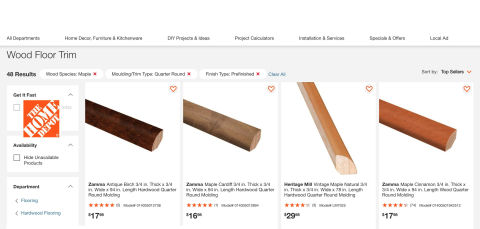
On 2021-06-24 by Cynthia Faraday
We have a house built in 1914 in Saint Paul, MN. We thought this small bit of wood floor we recently refinished was maple, but the poly we used on the floor produces a completely different effect on the new maple quarter round. Instead of turning the pale wood a golden, almost iridescent color as it did on the floor, the quarter round remained the same pale color. Is this the effect of age, or are we dealing with a different wood altogether?
On 2021-04-12 by (mod) - identify wood flooring in an 1890 Milton Massachusetts U.S. home
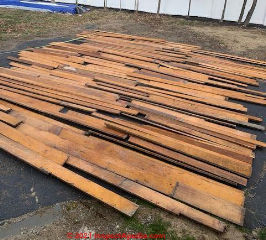
GD
Common clear pine was widely used as flooring in Massachusetts; if you can gouge the wood with a thumbnail - meaning it's fairly soft - it's probably pine; that's what the top board wood grain pattern resembles in your close-up photo below. When we see that wood grain pattern that board was "flat sawn" like the Ponderosa Pine wood sample I show above from Edlin (1969).
In your more-distant photo above there isn't enough sharpness, even when click-on to enlarge the image, to be sure what we're seeing. From the color the wood looks a lot like Doug fir but going back to your closer photo below that top board argues for pine
Take a look at the examples of wood samples I excerpted from Edlin's excellent manual for wood identification that I cite near the end of the article above.
I haven't ruled out maple or poplar.
On 2021-04-12 by gdenardo
We removed hardwood floors as part of a renovation of our home in Milton MA built in 1890. We would like to identify the species so that we can try to sell it vs throwing in a dumpster seems tragic. Any help would be appreciated
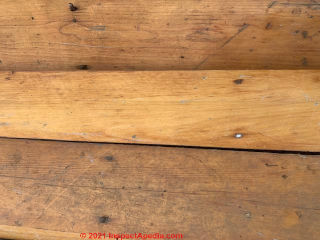
On 2020-05-21 by (mod) - identification of wood flooring as cherry vs. New Zealand's Jarrah
Ella
Are you sure that is original flooring from 1930?
It looks like Brazilian cherry..
If the floor is a native New Zealand wood, it could be Jarrah, as illustrated by the photo below, excerpted from a New Zealand flooring distributor, Kenneally Timber Products in ChristChurch, (a city we know and love), at Tel 03 327 2050, www.kenneallytimber.co.nz/node/17
Other dark reddish-brown New Zealand woods that may show up as flooring include
Blackwood,
New Zealand Cherry (Prunus avium),
and
Towai
But Jarrah, shown in my photo below from a floor we examined in Christchurch, is most-widely used and would be my best guess if your wood floor is not a recent-import product and is true wood, not an engineered wood or laminate product.
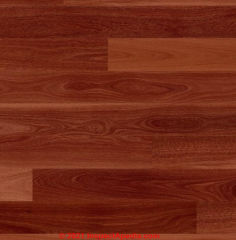
On 2020-05-21 by Ella
does anyone know what kind of wood this is? 1930s bungalow in NZ
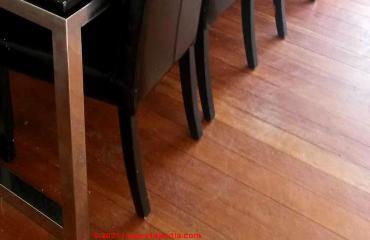
On 2019-12-14 by (mod) - thin wood flooring age
That looks like very thin flooring - if it is flooring at all, Kandi; Is it wood, plastic, laminated veneer, engineered wood?
What's the age of the building where this floor is installed?
If it's really flooring and it's less than 1/2" thick I suspect it's "modern" - even post 1970s.
On 2019-12-14 by Kandi
Can anyone give me a guess as how old this flooring is?
On 2019-07-17 by (mod) -
Looks like white pine
On 2019-07-16 by Andy
Would you be able to help identify these floors?
From a Pennsylvania house built 1928. They are 3 -1/8" wide, tongue and groove. They are on the second floor.
There are spots with very large gaps. Would you think it's worth restoring these floors? Thank you!
Could you help identify this wood flooring? Would it be worth restoring? In a Pennsylvania home built in 1928, second floor. It's 3 1-8" tongue and groove. Some large gaps
On 2019-07-15 by (mod) -
It's a milk substitute I'm sure. That is Publications not open to different wood species.
Let's be sure we're talking about wood and not a laminate flooring. Frankly while I'm sure there are some perfectly acceptable products being shipped when flooring products are coming from China I'm never sure exactly what we're getting
On 2019-07-14 by Rudy Long
A contractor wants to replace my damaged oak flooring with Palm Acacia 3/4 × 4 3/4-B. Is this an oak or oak substitute. It was shipped from China and sold thru Virginia Mill Works and Lumber Liquidators.
On 2018-12-19 by (mod) -
Not certain CK but
The wood grain in your photo looks like white oak, with a dark stain.
The absence of much yellow is a factor I considered (old oak is thus very different from pine that is more yellow and pine nearly always has more knots than oak).
The grain indentations that picked up more stain in your wood also argue for oak. Softwoods like pine have less grain indention.
You can also distinguish oak from pine by hardness: pine is much softer and on a floor is more likely to show gouges and dents than an oak floor.
The grain of your wood is open - not like maple.
Other flooring like birch, cherry or hickory or bamboo are so different as to not be in the running here.
This US FPL link https://www.fpl.fs.fed.us/research/centers/woodanatomy/wood_idfactsheet.php to the US FPL's Wood Identification Service may be of interest. A US Citizen can send a few samples per year for free wood ID by FPL.
We sometimes also use "black light" or UV to see if the wood will fluoresce - a feature that gets some wood experts excited. In my view, because so many completely different wood species will fluoresce to about the same hue, wood fluorescence is an interesting but not that great a tool overall. For example 40 to 50 different wood species will fluoresce yellow or yellow-green.
Fluorescence can, however separate some wood lookalikes such as locust (that will fluoresce) from mulberry (that will not fluoresce).
On 2018-12-19 by CK
I want to identify the wood floors in my house. I've attached a picture. Any help is greatly appreciated!
IMAGE LOST by older version of Clark Van Oyen’s useful Comments code - now fixed. Please re-post the image if you can. Sorry. Mod.
...
Continue reading at WOOD FLOOR ENGINEERED & SOLID or select a topic from the closely-related articles below, or see the complete ARTICLE INDEX.
Or see these
Recommended Articles
- HARDBOARD MASONITE™ & OTHER BRANDS - wood fibre identification example
- LAMINATE WOOD FLOOR
- OAK FLOORING NOMA CATALOG 1950 [PDF]
- TRAPPED MOLD BETWEEN WOOD SURFACES
- WOOD FLOOR AGE TYPES HISTORY
- WOOD FLOOR DAMAGE REPAIR
- WOOD FLOOR ENGINEERED & SOLID
- WOOD FLOOR ENGINEERED, REPAIRS
- WOOD FLOOR FINISHES
- WOOD FLOOR INSTALLATION
- WOOD FLOOR MOISTURE
- WOOD FLOOR, PARQUET
- WOOD FLOOR RADIANT HEAT
- WOOD FLOOR SOLID STRIP, PLANK
Suggested citation for this web page
WOOD FLOOR AGE TYPES HISTORY at InspectApedia.com - online encyclopedia of building & environmental inspection, testing, diagnosis, repair, & problem prevention advice.
Or see this
INDEX to RELATED ARTICLES: ARTICLE INDEX to BUILDING INTERIORS
Or use the SEARCH BOX found below to Ask a Question or Search InspectApedia
Ask a Question or Search InspectApedia
Try the search box just below, or if you prefer, post a question or comment in the Comments box below and we will respond promptly.
Search the InspectApedia website
Note: appearance of your Comment below may be delayed: if your comment contains an image, photograph, web link, or text that looks to the software as if it might be a web link, your posting will appear after it has been approved by a moderator. Apologies for the delay.
Only one image can be added per comment but you can post as many comments, and therefore images, as you like.
You will not receive a notification when a response to your question has been posted.
Please bookmark this page to make it easy for you to check back for our response.
Our Comment Box is provided by Countable Web Productions countable.ca
Citations & References
In addition to any citations in the article above, a full list is available on request.
- American Plywood Association, APA, "Portland Manufacturing Company, No. 1, a series of monographs on the history of plywood manufacturing",Plywood Pioneers Association, 31 March, 1967, www.apawood.org
- Isham: "An Example of Colonial Paneling", Norman Morrison Isham, The Metropolitan Museum of Art Bulletin, Vol. 6, No. 5 (May, 1911), pp. 112-116, available by JSTOR.
- Pergo AB, division of Perstorp AB, is a Swedish manufacturer or modern laminate flooring products. Information about the U.S. company can be found at http://www.pergo.com where we obtained historical data used in our discussion of the age of flooring materials in buildings.
- In addition to citations & references found in this article, see the research citations given at the end of the related articles found at our suggested
CONTINUE READING or RECOMMENDED ARTICLES.
- Carson, Dunlop & Associates Ltd., 120 Carlton Street Suite 407, Toronto ON M5A 4K2. Tel: (416) 964-9415 1-800-268-7070 Email: info@carsondunlop.com. Alan Carson is a past president of ASHI, the American Society of Home Inspectors.
Thanks to Alan Carson and Bob Dunlop, for permission for InspectAPedia to use text excerpts from The HOME REFERENCE BOOK - the Encyclopedia of Homes and to use illustrations from The ILLUSTRATED HOME .
Carson Dunlop Associates provides extensive home inspection education and report writing material. In gratitude we provide links to tsome Carson Dunlop Associates products and services.


